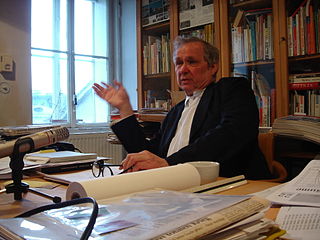
Thom Mayne is an American architect. He is based in Los Angeles. In 1972, Mayne helped found the Southern California Institute of Architecture (SCI-Arc), where he is a trustee and the coordinator of the Design of Cities postgraduate program. Since then he has held teaching positions at SCI-Arc, the California State Polytechnic University, Pomona and the University of California, Los Angeles (UCLA). He is principal of Morphosis Architects, an architectural firm based in Culver City, California and New York City, New York. Mayne received the Pritzker Architecture Prize in March 2005.

Hans Hollein was an Austrian architect and designer and key figure of postmodern architecture. Some of his most notable works are the Haas House and the Albertina extension in the inner city of Vienna.
Neil Leach is a British architect and theorist. He is also a licensed architect, registered to practice in the United Kingdom.

The A. Alfred Taubman College of Architecture and Urban Planning, also known as Taubman College, is the school of architecture and urban planning and one of the nineteen schools of the University of Michigan located in Ann Arbor, Michigan.

Jeffrey Kipnis is an American architectural critic, theorist, designer, film-maker, curator, and educator.
Barton Myers is an American architect and president of Barton Myers Associates Inc. in Santa Barbara, California. With a career spanning more than 40 years, Myers is a fellow of the American Institute of Architects and was a member of the Ontario Association of Architects while working in Canada earlier in his career.
Mónica Ponce de León is a Latina architect, educator, and dean of the Princeton University School of Architecture.

The UCLA School of the Arts and Architecture is a professional school at the University of California, Los Angeles. Through its four degree-granting departments, it provides a range of course offerings and programs. Additionally, there are eight centers located within the school.

François Valentiny is a Luxembourgish architect. After his studies in architecture at the Ecole d'Architecture de Nancy and the University of Applied Arts Vienna, in 1980 he formed a partnership with Hubert Hermann, founding the architects' office Hermann & Valentiny in Luxembourg and Vienna. He first advised for the city of Trier, and later became a visiting lecturer at the Department of Architecture, University of Applied Sciences Trier.

The MAK – Museum of Applied Arts is an arts and crafts museum located at Stubenring 5 in Vienna's 1st district Innere Stadt. Besides its traditional orientation towards arts and crafts and design, the museum especially focuses on architecture and contemporary art. The museum has been at its current location since 1871. Since 2004 the building is illuminated in the evenings by the permanent outdoor installation "MAKlite" of American artist James Turrell. In 2015 the MAK became the first museum to use bitcoin to acquire art, when it purchased the screensaver "Event listeners" of van den Dorpel. With over 300,000 objects displayed online, the MAK presents the largest online collection within the Austrian Federal Museums. The audio guide to this museum is provided as a web-based app.

Benjamin H. Bratton is an American Philosopher of Technology known for his work spanning social theory, computer science, design, artificial intelligence, and for his writing on the geopolitical implications of what he terms "planetary scale computation".
Caroline Bos is a Dutch architect. She is a co-founder of UNStudio, a large award-winning architecture firm in Amsterdam. Bos writes, lectures and teaches architecture at various schools. Her architectural drawings and models are shown at museums like MoMA.

Peter Noever is an Austrian designer and curator–at–large of art, architecture and media. From 1986 to 2011 he was the artistic director and CEO of MAK—Austrian Museum of Applied Arts and Contemporary Art in Vienna.

Max Hollein is an Austrian art historian and the current CEO and Director of the Metropolitan Museum of Art in New York City. He served as Director and CEO of the Fine Arts Museums of San Francisco from July 2016, until April 2018, the Metropolitan Museum of Art announced that Hollein would become its 10th director.

Hermann Czech is an Austrian architect. He was born and lives in Vienna, Austria, where he has a private practice.
Sergison Bates architects is an architectural practice with an office in London and Zürich. It was founded by Jonathan Sergison and Stephen Bates in 1996 in London. In addition to the two founding partners, their long-standing collaborator Mark Tuff has been a partner of the practice. Sergison Bates architects are best known for their residential buildings but have also realised public and institutional projects in the UK, continental Europe and China. In addition to their work as practising architects both Jonathan Sergison and Stephen Bates have taught architecture at various universities. Jonathan Sergison is a professor at the Accademia di Architettura in Mendrisio, whilst Stephen Bates is Professor and joint head of the Department for Urban Planning and Housing at the Technical University of Munich together with Bruno Krucker. Both architects have written and lectured on a wide range of topics related to architectural design. In 2006 they were awarded the prestigious Heinrich Tessenow Gold Medal and Erich Schelling Medal for their contribution to architecture.
Walter Pichler was an Austrian sculptor, artist, architect and designer.

Hubert Klumpner is an Austrian, architect, urbanist, educator, researcher, curator and activist.

Nina Hollein is an Austrian author, architect, and fashion designer based in New York City.

Wolf Dieter Prix is an Austrian architect. In 1968 he co-founded the architects' cooperative Coop Himmelb(l)au, which has an international reputation as an important representative of deconstructivism.













